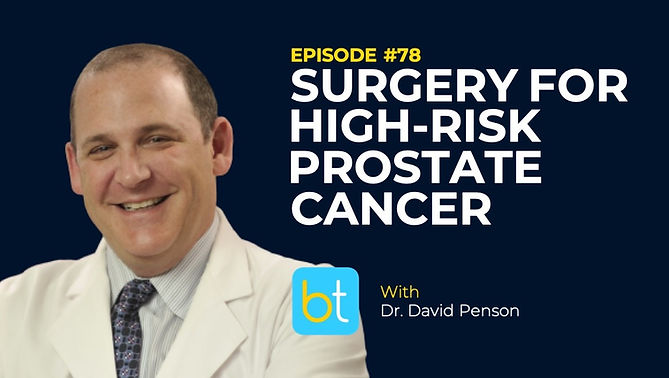BackTable / Urology / Podcast / Episode #78
Surgery for High-Risk Prostate Cancer
with Dr. David Penson
In this episode of BackTable Urology, Dr. Aditya Bagrodia interviews Dr. David Penson, professor and chair of urologic oncology at Vanderbilt University, about the indications and benefits of surgery for high risk prostate cancer.
Be part of the conversation. Put your sponsored messaging on this episode. Learn how.

BackTable, LLC (Producer). (2023, February 1). Ep. 78 – Surgery for High-Risk Prostate Cancer [Audio podcast]. Retrieved from https://www.backtable.com
Stay Up To Date
Follow:
Subscribe:
Sign Up:
Podcast Contributors
Synopsis
First, Dr. David Penson gives the traditional definition of high-risk prostate cancer, which is a PSA level over 20 ng/mL, a Gleason grade greater than 10, and a cancer staged at T2 or higher. However, he notes that in recent years, a more heterogeneous criteria has developed, so some patients with a Gleason grade greater than 8 and a T3 stage can also be considered high risk. Dr. Penson believes that pathological analysis is the best criteria to use when assessing risk and also uses MRI to distinguish between T2 and T3 patients and look for the median lobe before surgery. In his personal experience, he has noted that some patients will find online information about prostate cancer as a relatively benign chronic disease. For patients with high risk cancer, it is important to emphasize that the conventional active surveillance approach for low risk prostate cancer will not be beneficial. Both doctors agree that sending their patients curated, quality information is important and recommend using the WellPrept app. The doctors also discuss different imaging modalities involved in staging, such as PSMA PET scan, a bone scan, and prostate MRI. Before surgery, patients may receive neoadjuvant treatment. In the past, GnRH agonists were used, but long term data showed that patients receiving this type of therapy in addition to surgery had the same recurrence rate as patients who underwent surgery alone. Recently, newer neoadjuvant treatments, like PARP inhibitors, have been developed.
Next, Dr. Penson speaks about choosing surgery versus radiation therapy (RT) as a primary treatment. The main risk of prostatectomy is its impact on continence and sexual dysfunction. The downside of radiation therapy is that the possibility of surgery as a therapeutic option is eliminated and its side effects, such as irritating urinary symptoms. Dr. Penson also notes that nerve sparing prostatectomies may be cancer sparing. In his opinion, if patients have impotence at baseline, nerve sparing surgery is not beneficial because of the risk of leaving positive margins. Contraindications to surgery include rectal involvement, a history of multiple abdominal surgeries, severe heart disease, bladder neck involvement, and a high volume nodal disease. Ideal prostatectomy patients are ones who have high grade disease contained in the prostate (T2) and patients with preexisting lower urinary tract symptoms (LUTS).
Finally, the doctors discuss the use of nomograms to determine the extent of cancer control and the need for additional therapy. Dr. Penson has limited use for nomograms. He believes that they can generally be used to predict mortality, but not cure rates. He prefers to base prognosis on postoperative results. If the postoperative pathology report comes back with widely positive margins or bladder neck involvement, he discusses RT as an adjuvant treatment with his patients. For this reason, he emphasizes the need for collaboration with radiation oncologists and multidisciplinary tumor boards.
Resources
WellPrept App:
https://wellprept.com/
The Materials available on BackTable are for informational and educational purposes only and are not a substitute for the professional judgment of a healthcare professional in diagnosing and treating patients. The opinions expressed by participants of the BackTable Podcast belong solely to the participants, and do not necessarily reflect the views of BackTable.










